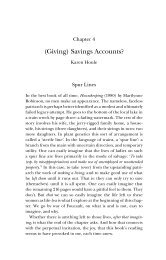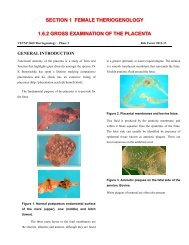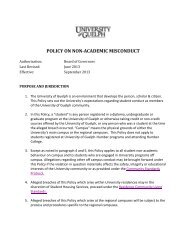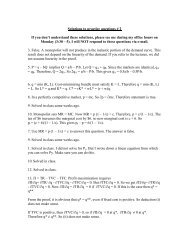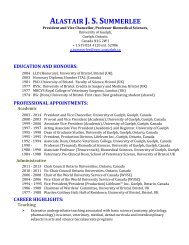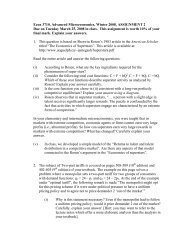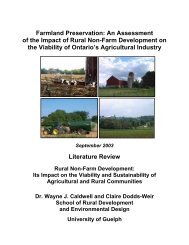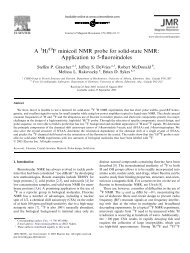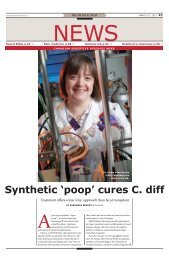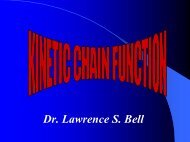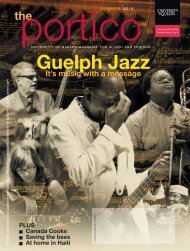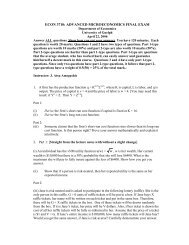Predicted impact of barriers to migration on the Serengeti wildebeest ...
Predicted impact of barriers to migration on the Serengeti wildebeest ...
Predicted impact of barriers to migration on the Serengeti wildebeest ...
You also want an ePaper? Increase the reach of your titles
YUMPU automatically turns print PDFs into web optimized ePapers that Google loves.
Road Impact <strong>on</strong> Wildebeest Migrati<strong>on</strong>Z than <strong>the</strong> cell <strong>the</strong>y have left. In our initial versi<strong>on</strong> <str<strong>on</strong>g>of</str<strong>on</strong>g> <strong>the</strong> model[28], movement and local populati<strong>on</strong> dynamics were slightlydecoupled. The former was a functi<strong>on</strong> <str<strong>on</strong>g>of</str<strong>on</strong>g> Z and <strong>the</strong> latter <str<strong>on</strong>g>of</str<strong>on</strong>g> Z/W,as follows:ZDW~ b W {m W exp {a WWW{HzVð3ÞIn eq. 3, DW is <strong>the</strong> change in <strong>wildebeest</strong> populati<strong>on</strong> density in agiven lattice cell at each time step. This is a combinati<strong>on</strong> <str<strong>on</strong>g>of</str<strong>on</strong>g> localpopulati<strong>on</strong> dynamics (<strong>the</strong> first term <strong>on</strong> <strong>the</strong> r.h.s.) minus e<str<strong>on</strong>g>migrati<strong>on</strong></str<strong>on</strong>g>H plus im<str<strong>on</strong>g>migrati<strong>on</strong></str<strong>on</strong>g> V from neighboring cells. The implementati<strong>on</strong>in eq. 3 independently provides good fits <str<strong>on</strong>g>to</str<strong>on</strong>g> movement dataand populati<strong>on</strong> dynamic data, but it is largely phenomenologicalin that <strong>the</strong> fac<str<strong>on</strong>g>to</str<strong>on</strong>g>r that drives movement (Z) differs from <strong>the</strong> fac<str<strong>on</strong>g>to</str<strong>on</strong>g>rthat maximizes per capita populati<strong>on</strong> growth (a proxy for fitness).A side effect <str<strong>on</strong>g>of</str<strong>on</strong>g> this is that simulated <strong>wildebeest</strong> do not necessarilymake movement ‘‘choices’’ that maximize fitness. To make <strong>the</strong>model more mechanistic and internally c<strong>on</strong>sistent, we replaced Z/W <strong>on</strong> <strong>the</strong> r.h.s. <str<strong>on</strong>g>of</str<strong>on</strong>g> eq. 3 with Z:DW~ ½b W {m W exp ð{a W ZÞŠW{HzV ð4ÞThis required a recalibrati<strong>on</strong> <str<strong>on</strong>g>of</str<strong>on</strong>g> parameter a w from 0.21 <str<strong>on</strong>g>to</str<strong>on</strong>g> 0.24in eq. 3 <str<strong>on</strong>g>to</str<strong>on</strong>g> produce a l<strong>on</strong>g-term <strong>wildebeest</strong> populati<strong>on</strong> <str<strong>on</strong>g>of</str<strong>on</strong>g> 1.2milli<strong>on</strong> under ‘‘normal’’ c<strong>on</strong>diti<strong>on</strong>s. This is <strong>the</strong> mean steady-statesize <str<strong>on</strong>g>of</str<strong>on</strong>g> <strong>the</strong> <strong>Serengeti</strong> <strong>wildebeest</strong> populati<strong>on</strong> post-rinderpest (whendisease kept <strong>the</strong> populati<strong>on</strong> in check). We kept all o<strong>the</strong>r modelparameters unaltered with respect <str<strong>on</strong>g>to</str<strong>on</strong>g> earlier model versi<strong>on</strong>s. Thefull set <str<strong>on</strong>g>of</str<strong>on</strong>g> model equati<strong>on</strong>s and parameters is given in [28].Figure 4. Simulated effects <str<strong>on</strong>g>of</str<strong>on</strong>g> movement <strong>on</strong> <strong>wildebeest</strong>populati<strong>on</strong> size in <strong>the</strong> <strong>Serengeti</strong>: A) mean (100 runs) populati<strong>on</strong>size for <strong>the</strong> default (no barrier, <str<strong>on</strong>g>migrati<strong>on</strong></str<strong>on</strong>g>/movement allowed) scenario(black) from Fig. 2 and a no <str<strong>on</strong>g>migrati<strong>on</strong></str<strong>on</strong>g> scenario in which <strong>wildebeest</strong> aretreated as residents and prevented from moving am<strong>on</strong>g lattice cells(red). The standard deviati<strong>on</strong>s for each scenario are indicated withdashed lines. B) Mean m<strong>on</strong>thly per capita populati<strong>on</strong> change (r)weighted spatially by <strong>wildebeest</strong> occupancy during <strong>the</strong> initial 10-yearperiod <str<strong>on</strong>g>of</str<strong>on</strong>g> populati<strong>on</strong> collapse shown in A: <strong>the</strong> <str<strong>on</strong>g>migrati<strong>on</strong></str<strong>on</strong>g> and no<str<strong>on</strong>g>migrati<strong>on</strong></str<strong>on</strong>g> scenarios are c<strong>on</strong>trasted, as well as values <str<strong>on</strong>g>of</str<strong>on</strong>g> r for individualcells from <strong>the</strong> nor<strong>the</strong>rn woodlands (N cell) and sou<strong>the</strong>rn plains (S cell)from <strong>the</strong> no <str<strong>on</strong>g>migrati<strong>on</strong></str<strong>on</strong>g> scenario.doi:10.1371/journal.p<strong>on</strong>e.0016370.g004Z~gI G N qHere, g is <strong>the</strong> proporti<strong>on</strong> <str<strong>on</strong>g>of</str<strong>on</strong>g> each cell occupied by grass (afuncti<strong>on</strong> <str<strong>on</strong>g>of</str<strong>on</strong>g> tree cover, which for simplicity and <str<strong>on</strong>g>to</str<strong>on</strong>g> limit sources <str<strong>on</strong>g>of</str<strong>on</strong>g>uncertainty we keep c<strong>on</strong>stant in <strong>the</strong> present simulati<strong>on</strong>s) and q is aparameter. Wildebeest e<str<strong>on</strong>g>migrati<strong>on</strong></str<strong>on</strong>g> from a lattice cell (H) is afuncti<strong>on</strong> <str<strong>on</strong>g>of</str<strong>on</strong>g> local resource availability Z and expected Z across <strong>the</strong>entire landscape, E(Z):H~ EZ ð ÞQðZÞ Q zEZ ð Þ QEmigrating <strong>wildebeest</strong> distribute <strong>the</strong>mselves proporti<strong>on</strong>atelythroughout <strong>the</strong> subset <str<strong>on</strong>g>of</str<strong>on</strong>g> target cells in <strong>the</strong> landscape with greaterð1Þð2ÞModel scenariosWe used <strong>the</strong> SD model <str<strong>on</strong>g>to</str<strong>on</strong>g> make l<strong>on</strong>g-term (100-yearsimulati<strong>on</strong>s) projecti<strong>on</strong>s <str<strong>on</strong>g>of</str<strong>on</strong>g> <strong>wildebeest</strong> abundance for both ‘‘nobarrier’’ (<strong>the</strong> status quo), and ‘‘barrier’’ scenarios, under which <strong>the</strong>proposed road acts as a physical barrier <str<strong>on</strong>g>to</str<strong>on</strong>g> <str<strong>on</strong>g>migrati<strong>on</strong></str<strong>on</strong>g> and cleaves<strong>the</strong> ecosystem in<str<strong>on</strong>g>to</str<strong>on</strong>g> two separate habitats: a Nor<strong>the</strong>rn compartmentcomprising 6,700 km 2 , and a Sou<strong>the</strong>rn compartment comprising24,000 km 2 , or 22 and 78% <str<strong>on</strong>g>of</str<strong>on</strong>g> <strong>the</strong> current extent <str<strong>on</strong>g>of</str<strong>on</strong>g> <strong>the</strong> <str<strong>on</strong>g>migrati<strong>on</strong></str<strong>on</strong>g>,respectively. Both <str<strong>on</strong>g>of</str<strong>on</strong>g> <strong>the</strong>se compartments c<strong>on</strong>tain mixtures <str<strong>on</strong>g>of</str<strong>on</strong>g> opengrasslands (mainly in <strong>the</strong> sou<strong>the</strong>rn plains) and woodland withvariable amounts <str<strong>on</strong>g>of</str<strong>on</strong>g> tree cover. To simulate <strong>the</strong> presence <str<strong>on</strong>g>of</str<strong>on</strong>g> abarrier, we split <strong>the</strong> model lattice in<str<strong>on</strong>g>to</str<strong>on</strong>g> a nor<strong>the</strong>rn and sou<strong>the</strong>rncompartment, with <strong>the</strong> size and shape <str<strong>on</strong>g>of</str<strong>on</strong>g> <strong>the</strong> compartmentsdetermined by <strong>the</strong> proposed road layout [6] (Fig. 1). When nobarrier is present, <strong>wildebeest</strong> are able <str<strong>on</strong>g>to</str<strong>on</strong>g> move freely across <strong>the</strong>entire landscape according <str<strong>on</strong>g>to</str<strong>on</strong>g> eq. 1, but when a barrier is present,we assumed that <strong>the</strong> sou<strong>the</strong>rn and nor<strong>the</strong>rn subpopulati<strong>on</strong>s <strong>on</strong>lymove within <strong>the</strong>ir compartments. To test for an effect <str<strong>on</strong>g>of</str<strong>on</strong>g> <strong>the</strong>barrier <strong>on</strong> <strong>wildebeest</strong> populati<strong>on</strong> size, we c<strong>on</strong>ducted 100 modelruns, each with randomly-drawn rainfall time series (but withidentical time series applied <str<strong>on</strong>g>to</str<strong>on</strong>g> <strong>the</strong> barrier and no barrier scenariosfor each run), and calculated <strong>the</strong> percent deviati<strong>on</strong> in final<strong>wildebeest</strong> populati<strong>on</strong> size between <strong>the</strong> two scenarios (for <strong>the</strong>barrier scenario, <strong>the</strong> sum <str<strong>on</strong>g>of</str<strong>on</strong>g> <strong>the</strong> nor<strong>the</strong>rn and sou<strong>the</strong>rn subpopulati<strong>on</strong>s).We also simulated an extreme ‘‘no <str<strong>on</strong>g>migrati<strong>on</strong></str<strong>on</strong>g>’’ scenario thateffectively prevents <strong>the</strong> <strong>wildebeest</strong> from moving am<strong>on</strong>g latticecells, essentially forcing <strong>the</strong>m <str<strong>on</strong>g>to</str<strong>on</strong>g> become sedentary, i.e., groups <str<strong>on</strong>g>of</str<strong>on</strong>g><strong>wildebeest</strong> can forage within <strong>the</strong>ir 100 km 2 home ranges (latticecells), but not in adjacent cells. Though not necessarily a realisticPLoS ONE | www.plos<strong>on</strong>e.org 5 January 2011 | Volume 6 | Issue 1 | e16370



